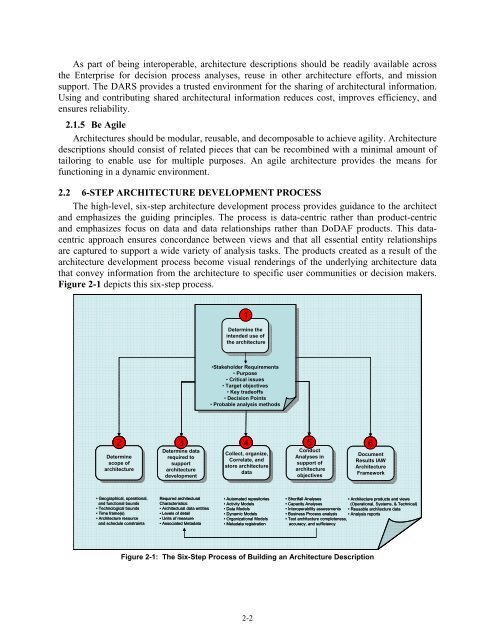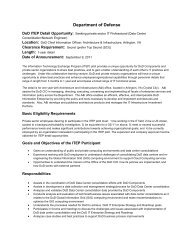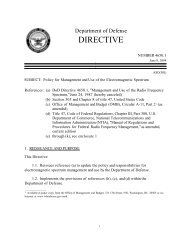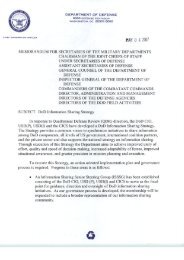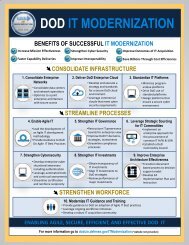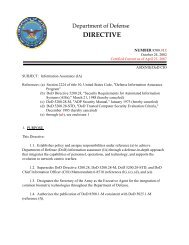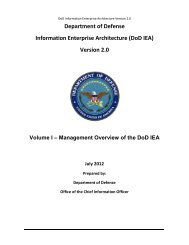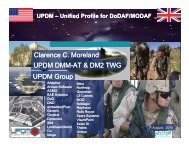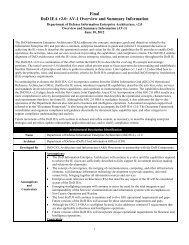DoD Architecture Framework Version 1.5 - Chief Information Officer
DoD Architecture Framework Version 1.5 - Chief Information Officer
DoD Architecture Framework Version 1.5 - Chief Information Officer
Create successful ePaper yourself
Turn your PDF publications into a flip-book with our unique Google optimized e-Paper software.
As part of being interoperable, architecture descriptions should be readily available across<br />
the Enterprise for decision process analyses, reuse in other architecture efforts, and mission<br />
support. The DARS provides a trusted environment for the sharing of architectural information.<br />
Using and contributing shared architectural information reduces cost, improves efficiency, and<br />
ensures reliability.<br />
2.<strong>1.5</strong> Be Agile<br />
<strong>Architecture</strong>s should be modular, reusable, and decomposable to achieve agility. <strong>Architecture</strong><br />
descriptions should consist of related pieces that can be recombined with a minimal amount of<br />
tailoring to enable use for multiple purposes. An agile architecture provides the means for<br />
functioning in a dynamic environment.<br />
2.2 6-STEP ARCHITECTURE DEVELOPMENT PROCESS<br />
The high-level, six-step architecture development process provides guidance to the architect<br />
and emphasizes the guiding principles. The process is data-centric rather than product-centric<br />
and emphasizes focus on data and data relationships rather than <strong>DoD</strong>AF products. This datacentric<br />
approach ensures concordance between views and that all essential entity relationships<br />
are captured to support a wide variety of analysis tasks. The products created as a result of the<br />
architecture development process become visual renderings of the underlying architecture data<br />
that convey information from the architecture to specific user communities or decision makers.<br />
Figure 2-1 depicts this six-step process.<br />
1<br />
Determine the<br />
Determine the<br />
intended use of<br />
intended use of<br />
the architecture<br />
the architecture<br />
•Stakeholder Requirements<br />
• Purpose<br />
• Critical issues<br />
• Target objectives<br />
• Key tradeoffs<br />
• Decision Points<br />
• Probable analysis methods<br />
2<br />
Determine<br />
Determine<br />
scope of<br />
scope of<br />
architecture<br />
architecture<br />
3<br />
Determine data<br />
Determine data<br />
required to<br />
required to<br />
support<br />
support<br />
architecture<br />
architecture<br />
development<br />
development<br />
4<br />
Collect, organize,<br />
Collect, organize,<br />
Correlate, and<br />
Correlate, and<br />
store architecture<br />
store architecture<br />
data<br />
data<br />
5<br />
Conduct<br />
Conduct<br />
Analyses in<br />
Analyses in<br />
support of<br />
support of<br />
architecture<br />
architecture<br />
objectives<br />
objectives<br />
6<br />
Document<br />
Document<br />
Results IAW<br />
Results IAW<br />
<strong>Architecture</strong><br />
<strong>Architecture</strong><br />
<strong>Framework</strong><br />
<strong>Framework</strong><br />
• Geographical, operational,<br />
and functional bounds<br />
• Technological bounds<br />
• Time frame(s)<br />
• <strong>Architecture</strong> resource<br />
and schedule constraints<br />
Required architectural<br />
Characteristics:<br />
• Architectural data entities<br />
• Levels of detail<br />
• Units of measure<br />
• Associated Metadata<br />
• Automated repositories<br />
• Activity Models<br />
• Data Models<br />
• Dynamic Models<br />
• Organizational Models<br />
• Metadata registration<br />
• Shortfall Analyses<br />
• <strong>Architecture</strong> products and views<br />
• Capacity Analyses<br />
(Operational, Systems, & Technical)<br />
• Interoperability assessments<br />
• Reusable architecture data<br />
• Business Process analysis<br />
• Analysis reports<br />
• Test architecture completeness,<br />
accuracy, and sufficiency<br />
Figure 2-1: The Six-Step Process of Building an <strong>Architecture</strong> Description<br />
2-2


